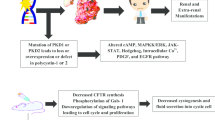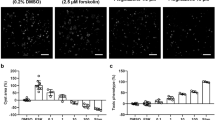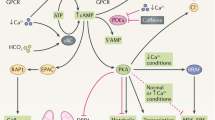Abstract
Background
Increased levels of cyclooxygenase (COX) derived oxylipins is the earliest and most consistent alteration in the renal oxylipin profile in diverse models of cystic kidney diseases. Therefore, we examined whether a COX2 inhibitor would reduce disease progression in the Pkd2WS25/− mouse model of autosomal dominant polycystic kidney disease (ADPKD).
Methods
Weanling normal and diseased male Pkd2 mice were provided diets that provided 0 or 50 mg celecoxib/kg body weight/day, for 13 weeks. Renal disease and function were assessed by histomorphometric analysis of renal cysts and measurement of serum creatinine and urea nitrogen (SUN) levels. Targeted lipidomic analysis of renal oxylipins was performed by HPLC–MS/MS.
Results
Diseased mice had significant cyst involvement and reduced renal function as indicated by elevated serum creatinine and SUN. Celecoxib reduced cyst area by 48%, cyst volume by 70%, and serum creatinine and SUN by 20% and 16%, respectively. Consistent with our previous studies, 8 of the 11 COX derived oxylipins were higher in diseased kidneys. In addition, 24 of 33 lipoxygenase (LOX) derived oxylipins and 7 of 16 cytochrome P450 (CYP) derived oxylipins were lower in diseased kidneys. Celecoxib reduced total and five of the eight individual elevated COX oxylipins and increased 5 of 24 LOX and 5 of 7 CYP oxylipins that were reduced by disease.
Conclusions
COX2 inhibition ameliorates disease progression, improves renal function and improves the altered oxylipins in Pkd2 mice. This represents a potential new approach for treatment of ADPKD, a disorder for which no effective treatment currently exists.


Similar content being viewed by others
References
Harris PC, Torres VE (2009) Polycystic kidney disease. Annu Rev Med 60:321–337
Blanchette CM, Liang C, Lubeck DP, Newsome B, Rossetti S, Gu X, Gutierrez B, Lin ND (2015) Progression of autosomal dominant kidney disease: measurement of the stage transitions of chronic kidney disease. Drugs Context 4:212275
Luo F, Tao YH (2018) Nephronophthisis: a review of genotype–phenotype correlation. Nephrology (Carlton). https://doi.org/10.1111/nep.13393
Magistroni R, Boletta (2017) Defective glycolysis and the use of 2-deoxy-d-glucose in polycystic kidney disease: from animal models to humans. J Nephrol 30:511–519
Stewart JH (1994) End-stage renal failure appears earlier in men than in women with polycystic kidney disease. Am J Kidney Dis 24:181–183
Yamaguchi T, Devassy JG, Gabbs M, Ravandi A, Nagao S, Aukema HM (2015) Dietary flax oil rich in alpha-linolenic acid reduces renal disease and oxylipin abnormalities, including formation of docosahexaenoic acid derived oxylipins in the CD1-pcy/pcy mouse model of nephronophthisis. Prostaglandins Leukot Essent Fatty Acids 94:83–89
Yamaguchi T, Lysecki C, Reid A, Nagao S, Aukema HM (2014) Renal cyclooxygenase products are higher and lipoxygenase products are lower in early disease in the pcy mouse model of adolescent nephronophthisis. Lipids 49:39–47
Ibrahim NH, Jia Y, Devassy JG, Yamaguchi T, Aukema HM (2014) Renal cyclooxygenase and lipoxygenase products are altered in polycystic kidneys and by dietary soy protein and fish oil treatment in the Han:SPRD-Cy rat. Mol Nutr Food Res 58:768–781
Monirujjaman M, Devassy JG, Yamaguchi T, Sidhu N, Kugita M, Gabbs M, Nagao S, Zhou J, Ravandi A, Aukema HM (2017) Distinct oxylipin alterations in diverse models of cystic kidney diseases. Biochim Biophys Acta 1862:1562–1574
Gabbs M, Leng S, Devassy JG, Monirujjaman M, Aukema HM (2015) Advances in our understanding of oxylipins derived from dietary PUFAs. Adv Nutr 6:513–540
Camara NO, Martins JO, Landgraf RG, Jancar S (2009) Emerging roles for eicosanoids in renal diseases. Curr Opin Nephrol Hypertens 18:21–27
Warford-Woolgar L, Peng CY, Shuhyta J, Wakefield A, Sankaran D, Ogborn M, Aukema HM (2006) Selectivity of cyclooxygenase isoform activity and prostanoid production in normal and diseased Han:SPRD-cy rat kidneys. Am J Physiol Renal Physiol 290:F897–F904
Aukema HM, Adolphe J, Mishra S, Jiang J, Cuozzo FP, Ogborn MR (2003) Alterations in renal cytosolic phospholipase A2 and cyclooxygenases in polycystic kidney disease. FASEB J 17:298–300
Bos CL, Richel DJ, Ritsema T, Peppelenbosch MP, Versteeg HH (2004) Prostanoids and prostanoid receptors in signal transduction. Int J Biochem Cell Biol 36:1187–1205
Diaz-Munoz MD, Osma-Garcia IC, Fresno M, Iñiguez MA (2012) Involvement of PGE2 and the cAMP signalling pathway in the up-regulation of COX-2 and mPGES-1 expression in LPS-activated macrophages. Biochem J 443:451–461
Klein T, Shephard P, Kleinert H, Kömhoff M (2007) Regulation of cyclooxygenase-2 expression by cyclic AMP. Biochim Biophys Acta 1773:1605–1618
Yamaguchi T, Nagao S, Kasahara M, Kömhoff M (1997) Renal accumulation and excretion of cyclic adenosine monophosphate in a murine model of slowly progressive polycystic kidney disease. Am J Kidney Dis 30:703–709
Putnam WC, Swenson SM, Reif GA, Wallace DP, Helmkamp GM Jr, Grantham JJ (2007) Identification of a forskolin-like molecule in human renal cysts. J Am Soc Nephrol 18:934–943
Yamaguchi T, Pelling JC, Ramaswamy NT, et Eppler JW, Wallace DP, Nagao S, Rome LA, Sullivan LP, Grantham JJ (2000) cAMP stimulates the in vitro proliferation of renal cyst epithelial cells by activating the extracellular signal-regulated kinase pathway. Kidney Int 57:1460–1471
Elberg G, Elberg D, Lewis TV, Guruswamy S, Chen L, Logan CJ, Chan MD, Turman MA (2007) EP2 receptor mediates PGE2-induced cystogenesis of human renal epithelial cells. Am J Physiol Renal Physiol 293:F1622–F1632
Elberg D, Turman MA, Pullen N, Elberg G (2012) Prostaglandin E2 stimulates cystogenesis through EP4 receptor in IMCD-3 cells. Prostaglandins Other Lipid Mediat 98:11–16
Yang B, Sonawane ND, Zhao D, Somlo S, Verkman AS (2008) Small-molecule CFTR inhibitors slow cyst growth in polycystic kidney disease. J Am Soc Nephrol 19:1300–1310
Albaqumi M, Srivastava S, Li Z, Zhdnova O, Wulff H, Itani O, Wallace DP, Skolnik EY (2008) KCa3.1 potassium channels are critical for cAMP-dependent chloride secretion and cyst growth in autosomal-dominant polycystic kidney disease. Kidney Int 74:740–749
Ibrahim NH, Gregoire M, Devassy JG, Wu Y, Yoshihara D, Yamaguchi T, Nagao S, Aukema HM (2015) Cyclooxygenase product inhibition with acetylsalicylic acid slows disease progression in the Han:SPRD-Cy rat model of polycystic kidney disease. Prostaglandins Other Lipid Mediat 116–117:19–25
Xu T, Wang NS, Fu LL, Ye CY, Yu SQ, Mei CL (2012) Celecoxib inhibits growth of human autosomal dominant polycystic kidney cyst-lining epithelial cells through the VEGF/Raf/MAPK/ERK signaling pathway. Mol Biol Rep 39:7743–7753
Sankaran D, Bankovic-Calic N, Ogborn MR, Crow G, Aukema HM (2007) Selective COX-2 inhibition markedly slows disease progression and attenuates altered prostanoid production in Han:SPRD-cy rats with inherited kidney disease. Am J Physiol Renal Physiol 293:F821–F830
Horl WH (2010) Nonsteroidal anti-inflammatory drugs and the kidney. Pharmaceuticals (Basel) 3:2291–2321
Wu G, D’Agati V, Cai Y, Markowitz G, Park JH, Reynolds DM, Maeda Y, Le TC, Hou H Jr, Kucherlapati R, Edelmann W, Somlo S (1998) Somatic inactivation of Pkd2 results in polycystic kidney disease. Cell 93:177–188
Olson JM, Haas AW, Lor J, McKee HS, Cook ME (2017) A Comparison of the anti-inflammatory effects of Cis-9, Trans-11 Conjugated linoleic acid to celecoxib in the collagen-induced arthritis model. Lipids 52:151–159
Nasrallah R, Robertson SJ, Karsh J, Hébert RL (2013) Celecoxib modifies glomerular basement membrane, mesangium and podocytes in OVE26 mice, but ibuprofen is more detrimental. Clin Sci (Lond) 124:685–694
Yamaguchi T, Devassy JG, Monirujjaman M, Gabbs M, Aukema HM (2016) Lack of benefit of early intervention with dietary flax and fish oil and soy protein in orthologous rodent models of human hereditary polycystic kidney disease. PLoS One 11:e0155790
Sankaran D, Lu J, Bankovic-Calic N, Ogborn MR, Aukema HM (2004) Modulation of renal injury in pcy mice by dietary fat containing n-3 fatty acids depends on the level and type of fat. Lipids 39:207–214
Hall LM, Murphy RC (1998) Electrospray mass spectrometric analysis of 5-hydroperoxy and 5-hydroxyeicosatetraenoic acids generated by lipid peroxidation of red blood cell ghost phospholipids. J Am Soc Mass Spectrom 9:527–532
Messchendorp AL, van Londen M, Taylor JM, de Borst MH, Navis G, Casteleijn NF et al (2018) Kidney function reserve capacity in early and later stage autosomal dominant polycystic kidney disease. Clin J Am Soc Nephrol. https://doi.org/10.2215/CJN.03650318
Ghata J, Cowley BD Jr (2017) Polycystic kidney disease. Compr Physiol 7:945–975
Yamaguchi T, Nagao S, Wallace DP, Belibi FA, Cowley BD, Pelling JC, Grantham JJ (2003) Cyclic AMP activates B-Raf and ERK in cyst epithelial cells from autosomal-dominant polycystic kidneys. Kidney Int 63:1983–1994
Wang Q, Cobo-Stark P, Patel V, Somlo S, Han PL, Igarashi P (2018) Adenylyl cyclase 5 deficiency reduces renal cyclic AMP and cyst growth in an orthologous mouse model of polycystic kidney disease. Kidney Int 93:403–415
Hopp K, Hommerding CJ, Wang X, Ye H, Harris PC, Torres VE (2015) Tolvaptan plus pasireotide shows enhanced efficacy in a PKD1 model. J Am Soc Nephrol 26:39–47
Torres VE, Chapman AB, Devuyst O, Gansevoort RT, Grantham JJ, Higashihara E et al (2012) Tolvaptan in patients with autosomal dominant polycystic kidney disease. N Engl J Med 367:2407–2418
Reif GA, Yamaguchi T, Nivens E, Fujiki H, Pinto CS, Wallace DP (2011) Tolvaptan inhibits ERK-dependent cell proliferation, Cl(−) secretion, and in vitro cyst growth of human ADPKD cells stimulated by vasopressin. Am J Physiol Renal Physiol 301:F1005–F1013
Zhang MZ, Sanchez Lopez P, McKanna JA, Harris RC (2004) Regulation of cyclooxygenase expression by vasopressin in rat renal medulla. Endocrinology 145:1402–1409
Hogan MC, Masyuk TV, Page LJ, Kubly VJ, Bergstralh EJ, Li X et al (2010) Randomized clinical trial of long-acting somatostatin for autosomal dominant polycystic kidney and liver disease. J Am Soc Nephrol 21:1052–1061
Masyuk TV, Radtke BN, Stroope AJ, Banales JM, Gradilone SA, Huang B, Masyuk AI, Hogan MC, Torres VE, Larusso NF (2013) Pasireotide is more effective than octreotide in reducing hepatorenal cystogenesis in rodents with polycystic kidney and liver diseases. Hepatology 58:409–421
Lakhia R, Hajarnis S, Williams D, Aboudehen K, Yheskel M, Xing C, Hatley ME, Torres VE, Wallace DP, Patel V (2016) MicroRNA-21 aggravates cyst growth in a model of polycystic kidney disease. J Am Soc Nephrol 27:2319–2330
Belibi FA1, Reif G, Wallace DP, Yamaguchi T, Olsen L, Li H, Helmkamp GM Jr, Grantham JJ (2004) Cyclic AMP promotes growth and secretion in human polycystic kidney epithelial cells. Kidney Int 66:964–973
Peacock O, Lee AC, Cameron F, Tarbox R, Vafadar-Isfahani N, Tufarelli C, Lund JN (2014) Inflammation and MiR-21 pathways functionally interact to downregulate PDCD4 in colorectal cancer. PLoS One 9:e110267
Wongrakpanich S, Wongrakpanich A, Melhado K, Rangaswami J (2018) A comprehensive review of non-steroidal anti-inflammatory drug use in the elderly. Aging Dis 9:143–150
Laine L (2002) The gastrointestinal effects of nonselective NSAIDs and COX-2-selective inhibitors. Semin Arthritis Rheum 32:25–32
Heleniak Z, Cieplińska M, Szychliński T, Rychter D, Jagodzińska K, Kłos A, Kuźmiuk I, Tylicka MJ, Tylicki L, Rutkowski B, Dębska-Ślizień A (2017) Nonsteroidal anti-inflammatory drug use in patients with chronic kidney disease. J Nephrol 30:781–786
Ahmad SR, Kortepeter C, Brinker A, Chen M, Beitz J (2002) Renal failure associated with the use of celecoxib and rofecoxib. Drug Saf 25:537–544
Warth LC, Noiseux NO, Hogue MH, Klaassen AL, Liu SS, Callaghan JJ (2016) Risk of acute kidney injury after primary and revision total hip arthroplasty and total knee arthroplasty using a multimodal approach to perioperative pain control including ketorolac and celecoxib. J Arthroplasty 31:253–255
Fair DE, Ogborn MR, Weiler HA, Bankovic-Calic N, Nitschmann EP, Fitzpatrick-Wong SC, Aukema HM (2004) Dietary soy protein attenuates renal disease progression after 1 and 3 weeks in Han:SPRD-cy weanling rats. J Nutr 134:1504–1507
Cahill LE, Peng CY, Bankovic-Calic N, Sankaran D, Ogborn MR, Aukema HM (2007) Dietary soya protein during pregnancy and lactation in rats with hereditary kidney disease attenuates disease progression in offspring. Br J Nutr 97:77–84
Reagan-Shaw S, Nihal M, Ahmad N (2008) Dose translation from animal to human studies revisited. FASEB J 22:659–661
Jozsef L, Zouki C, Petasis NA, Serhan CN, Filep JG (2002) Lipoxin A4 and aspirin-triggered 15-epi-lipoxin A4 inhibit peroxynitrite formation, NF-kappa B and AP-1 activation, and IL-8 gene expression in human leukocytes. Proc Natl Acad Sci USA 99:13266–13271
Imig JD, Zhao X, Zaharis CZ, Olearczyk JJ, Pollock DM, Newman JW, Kim IH, Watanabe T, Hammock BD (2005) An orally active epoxide hydrolase inhibitor lowers blood pressure and provides renal protection in salt-sensitive hypertension. Hypertension 46:975–981
Acknowledgements
We gratefully acknowledge T. Winter for her technical assistance.
Funding
This study was supported by a Grant from the Natural Sciences and Engineering Research Council of Canada (NSERC) (RGPIN-2015-03733) to HMA. Research studentship support was from the University of Manitoba Graduate Fellowship, Queen Elizabeth II Diamond Jubilee Scholarship, Janet Fabro McComb Scholarship and GETS Scholarship programs to MM.
Author information
Authors and Affiliations
Corresponding author
Ethics declarations
Conflict of interest
All authors declare that they have no conflict of interest.
Ethical statement
All applicable international, national, and/or institutional guidelines for the care and use of animals were followed. All procedures performed in studies involving animals were in accordance with the ethical standards of University of Manitoba.
Additional information
Publisher’s Note
Springer Nature remains neutral with regard to jurisdictional claims in published maps and institutional affiliations.
Electronic supplementary material
Below is the link to the electronic supplementary material.
Rights and permissions
About this article
Cite this article
Monirujjaman, M., Aukema, H.M. Cyclooxygenase 2 inhibition slows disease progression and improves the altered renal lipid mediator profile in the Pkd2WS25/− mouse model of autosomal dominant polycystic kidney disease. J Nephrol 32, 401–409 (2019). https://doi.org/10.1007/s40620-018-00578-8
Received:
Accepted:
Published:
Issue Date:
DOI: https://doi.org/10.1007/s40620-018-00578-8




